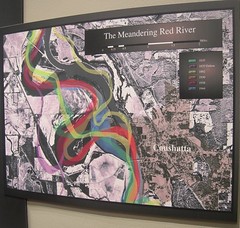Creating mental maps of the community is an important function in developing thinking skills.
map (map), n., v. mapped, mapping, n. 1. a drawing representing selected features of the earth’s surface or part of it. 2. a map like drawing of anything: a highway way, a weather map. v. 1. to make a map of; show on a map. 2. to collect information for a map by exploring or surveying a region.
How does one describe an area to someone who needs that info? How does one get from place A to place B most efficiently? How does one plan landscaping and imagine gardens and pavilions for the future? How does one develop property and greenways? Is there a way to enrich your understanding of an area? Of finding an area's less-obvious value?
It begins with informal mapping. Sketching, measuring, thinking creatively about how to See and capture the essence of an area.
The activity moves to comparison and research: compare your drawings to published maps. Can you integrate the 2 versions? is there a way in which your informal map has value?
Sharing maps with each other and discussing ways to incorporate elements of each map in a larger collaborative map adds value to students' sense of space and geography.
Many of these maps will be more conceptual than realistic or geographically correct. The sketches and charts that will come from students offer value by showing how students and artists think and feel about their community.
Coming up after China: sketch maps of the campus.
skip to main |
skip to sidebar
For students and parents who love education and exploration of the social sciences . . .
Search This Blog
Followers
Blog Archive
-
▼
2010
(346)
-
▼
April
(32)
- Hard Working Substitute Wei: "Not One Less" Wei Essay
- A quiz on the Odyssey of a Chinese Teen in Not One...
- Grab some chopsticks and bring them to class on Tues
- This weekend: Artbreak, Night of One-Acts, Relay f...
- Drop outs often find their way into the criminal j...
- Not One Less quiz on Thurs: see previous questions...
- Constructed response to the list of Japanese compa...
- Making Tibetan Buddhist flags in geography class o...
- The NY Times describes 36 hours in Kyoto, the impe...
- Product placement in Not One Less: Coca-Cola China
- Thurs reading comprehension quiz on Not One Less a...
- Vietnam vet interview: 15 pts / Book report: 20 pts
- The First Emperor Quiz
- Not One Less created by one of China's most succes...
- Final exam schedule May 25 - 27, 2010
- Wei Minzhi in Zhang Yimou's movie Not One Less
- Bonus credit for attending Shakespeare in the Cent...
- Week of Ap 18: Quiz on Wed and presentation on Fri...
- Mapping Magnet High and the area
- Alchemists and mercury
- Creating a dramatic presentation on the Middle Kin...
- Chinese tombs and embalming
- Map quiz followed by giant paper Chinese Mask maki...
- iLeap & GEE tests Mon - Wed, April 12 14, 8:30 am ...
- Bonus credit: attend the Magnet Choir's performanc...
- Qin Shi Huangdi review: the First Emperor and his ...
- Which would you rather carry to school: a laptop a...
- Indie work on China
- Chinese history via research and skits
- Chine 中国 - Shanghaï 上海
- Coming to the RFC: The Films of Ang Lee, April 5-9
- Domino theory and a gorilla in the living room: th...
-
▼
April
(32)

